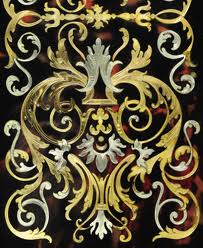
The art of marquetry developed in Italy during the fourteenth century.
From a technical point of view, the inlay is made with a decorative veneer cut in a pattern and glued on a support (furniture, wood paneling or table).
The resulting images can be geometric or figurative.
In the seventeenth century marquetry is spreading throughout Europe.
In France, it is André-Charles Boulle, master cabinetmaker who developed a technique that revolutionized the existing practice of marquetry. This method is called La Tarsia has Incastro: All veneers are stacked in a package.

Then comes the cutting of each form to the jigsaw called "marquetry easel".
We obtain, during assembly, plating clear that embeds itself in the dark wood and vice versa.
The "Boulle marquetry" also introduces a new specialty: the inlay of tortoiseshell.
 Details of a Louis XVI period marquetery commode inlaid with musical instruments
Details of a Louis XVI period marquetery commode inlaid with musical instruments
Marquetry became really famous in the seventeenth and eighteenth centuries in the styles of Louis XIV and Louis XV.
The materials most frequently used are
- Timber and its numerous species
- Metals: copper, brass, pewter, silver
- The materials of animal origin: tortoiseshell, horn, ivory, bone, pearl shagreen (fish skin)
- Stone and marble
- Straw
In the eighteenth century, cabinet makers, taking advantage of imports of "Isles's wood", realized substantial inlay work of precious furniture, dressers, secretary, coffee tables, corner, libraries ....
The species most used were rosewood, kingwood, mahogany, wood tobacco....